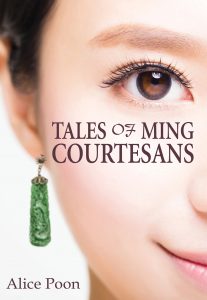What Inspired Me to Write Tales of Ming Courtesans
 May I introduce myself? My name is Alice Poon and I am a Hong Kong-Canadian historical novelist who writes in English, with an affinity for stories about notable but unsung Chinese women. Tales of Ming Courtesans is my second historical novel set in 17th century China, published in June 2020 by Earnshaw Books. My first was The Green Phoenix: A Novel of Empress Xiaozhuang, the Woman Who Re-made Asia (2017), released by the same publisher.
May I introduce myself? My name is Alice Poon and I am a Hong Kong-Canadian historical novelist who writes in English, with an affinity for stories about notable but unsung Chinese women. Tales of Ming Courtesans is my second historical novel set in 17th century China, published in June 2020 by Earnshaw Books. My first was The Green Phoenix: A Novel of Empress Xiaozhuang, the Woman Who Re-made Asia (2017), released by the same publisher.
Tales is a story about women’s struggles against oppression and abuse in a patriarchal society and about female friendship, with themes of human resilience, survival and hope. It tells the tragic stories of three beautiful and talented courtesans who are sold into slavery in early life and have to live with that stigma for the rest of their existence.
Chinese history has been written and organized with a strong patriarchal bias. It’s no surprise that Chinese historians have always dismissed out of hand notable women’s contributions to the arts and other areas, as well as their life stories. Fortunately for the initiated, there are still abundant literary sources from which such women’s works and narratives can be gleaned.
Just to give you an idea of how sexist official Chinese history is, I’ll share with you this little observation.
Several years ago, one day I was glancing through the lists of Official Biographies pertaining to the time stretch from 960 (the start of Song) right up to 1911 (the end of Qing), i.e. a total of nine-and-a-half centuries, and something hit me out of the blue.
[Note: I own history books covering the Song, Yuan, Ming and Qing dynasties from the modern edition of the collection entitled The Newer Twenty-Five Histories, which were compiled based on the orthodox Twenty-Four Histories and Draft History of Qing. The format of this orthodox historical canon is such that “Annals of Rulers” and “Official Biographies” make up the two major integral sections.]
It occurred to me that in this wide span of history only six females (four empresses and two woman rebels, yes, rebels) were deemed worthy of a little space in official history. [Admittedly some minor biographies have been winnowed out from the modern edition for clarity’s sake, but that does not invalidate my point about the gender bias in terms of selective recording.] Even for the four empresses who made the cut, on paper, their achievements were almost reduced to playing well the role of dutiful wives / mothers / guardians to emperors. Above all, female literary and artistic talents whose works should have been recognized were all conspicuous by their absence.
It made me sad just to think of all the lost and buried gems created by unsung Chinese women throughout the centuries, just because this patriarchal civilization had presumed women to be inferior and unworthy of mention in history.
Let me now turn to the specific reasons as to why I felt the urge to write this novel about these three ill-fated women from the late-Ming dynasty.
As I mentioned earlier, even though official history is not the go-to source for information about notable female literary and artistic talents, one can always glean from literary writings.
But then again, for hundreds of years, the stories of my main characters, Liu Rushi (a poetry prodigy), Chen Yuanyuan and Li Xiangjun (both divas of kunqu opera singing), have been told by men from the male perspective, typically focusing on their beauty and femininity. They tend to stereotype them as women romantically connected with famous men, and to conveniently gloss over the women’s artistic talents and their incredible moral grit and integrity in their fight against oppression and abuse.
Eminent historian Chen Yinke (1890 – 1969) was an outstanding exception. He found it worthwhile to spend 10 years of the latter part of his life to write the epic 800,000-word biography of Liu Rushi, lauding her as the embodiment of the nation’s spirit of independence and liberal thinking. Even then, his accolade still drew the cold sneer of his intellectual rival Qian Zhongshu (famous for his novel Fortress Besieged), who disdained Chen’s seminal work as frivolous.
After reading my research materials, I was convinced that there was only one way to do these women justice, and that is, to give them a voice and let them tell their own stories.
More importantly, I wanted readers to note the important fact that each of the three women left a lasting legacy on Chinese literature and operatic music respectively.
Liu Rushi was a poetry prodigy and was published by the age of 17. She left behind a significant body of poetic works and epistolary writings, which, since the publication of her biography in 1980, have drawn the serious attention of academicians. Some of her paintings can be found today at the Freer Gallery of Art in Washington DC.
Both Chen Yuanyuan and Li Xiangjun were renowned kunqu opera singers and their skills no doubt impacted on the development of China’s operatic art. Kunqu opera was the most popular form of entertainment in those times. It had originated in Kunshan in the Suzhou Prefecture and later spread to the whole of Jiangnan. It was in fact the precursor to the more well-known Peking opera. In 2001, UNESCO named kunqu opera as a masterpiece of intangible cultural heritage.
Lastly, I hope that my novel will send this message, which cannot be repeated often enough: that the world needs to make greater efforts to celebrate women’s contributions and to heed their voices, and that bullying women is a most craven act.
—
Tales of Ming Courtesans
 From the author of The Green Phoenix comes a riveting tale of female friendship, honor, and sacrifice for love, set in 17th Century China. Inspired by literary works and folklore, Tales of Ming Courtesans traces the destinies of three of the era’s most renowned courtesans from the seamy world of human trafficking and slavery to the cultured scene of the famously decadent pleasure district of Nanjing, evoking episodes in Memoirs of a Geisha.
From the author of The Green Phoenix comes a riveting tale of female friendship, honor, and sacrifice for love, set in 17th Century China. Inspired by literary works and folklore, Tales of Ming Courtesans traces the destinies of three of the era’s most renowned courtesans from the seamy world of human trafficking and slavery to the cultured scene of the famously decadent pleasure district of Nanjing, evoking episodes in Memoirs of a Geisha.
Jingjing is reading her mother Rushi’s memoir. A wretched adolescence barely behind her, Rushi, being a courtesan, loses her true love to the tyranny of conventions. Social scorn and ill fate keeps stalking her.
The memoir inspires Jingjing to uncover the tragic fates of Rushi’s two sworn sisters, also courtesans. Yuanyuan is first trapped in brutal slavery and then forced to let go of her lover and enter an unhappy union with a brutish general who later becomes a traitor. Xiangjun incurs corrupt courtiers’ wrath when she warns her lover of their trap laid for him. When the outbreak of war plunges the three women into deeper woes, they mull over a daring idea to preserve hope. In piecing the three sisters’ stories together, Jingjing slowly unravels the secret of who she really is.
Born and raised in Hong Kong, Alice Poon steeped herself in Chinese poetry and history, Jin Yong’s martial arts novels and English Literature in her school days. This early immersion has inspired her creative writing.
Always fascinated with iconic but unsung women in Chinese history and legends, she cherishes a dream of bringing them to the page.
She is the author of The Green Phoenix and the bestselling and award-winning non-fiction title Land and the Ruling Class in Hong Kong. She now lives in Vancouver, Canada and devotes her time to writing historical Chinese fiction.
http://alicewaihanpoon.blogspot.ca
https://www.instagram.com/alicepoonauthor
https://www.goodreads.com/alice_poon
https://www.facebook.com/AlicePoonWriter
https://www.facebook.com/alice.poon.author
Category: On Writing






























